Link: https://www.bloomberg.com/opinion/articles/2021-02-23/covid-19-isn-t-the-only-thing-shortening-american-lives
Graphic:
Excerpt:
The 2020 life expectancy numbers also underscore longer-term health challenges that were already alarming. For two to three decades, life expectancy has been improving much more rapidly for higher earners than for lower earners, and 2020 has probably made these gaps worse. The one bright spot in the differential trends before the pandemic had been a narrowing of racial differences. These new estimates show a dramatic reversal of that hopeful pattern. From the early 1990s to 2016, the racial gap in life expectancy for males at birth shrunk from more than 8 years to about 4.5. During the first half of 2020, it widened to more than 7 years.
…..
On the contrary, 2020 mortality data indicate that death rates from non-Covid causes rose, despite the economic recession. More Americans than expected died from diabetes, high blood pressure and pneumonia. Some of these deaths may have been misreported, and actually caused by Covid. But a large number may also reflect the challenges in providing non-Covid health care during the past year, as people have avoided hospitals, and government mandates have restricted discretionary medical procedures. The pandemic will provide hard lessons on which types of medical care truly improve health, and which ones can be safely skipped or delayed.
Author(s): Peter R. Orszag
Publication Date: 23 February 2021
Publication Site: Bloomberg




